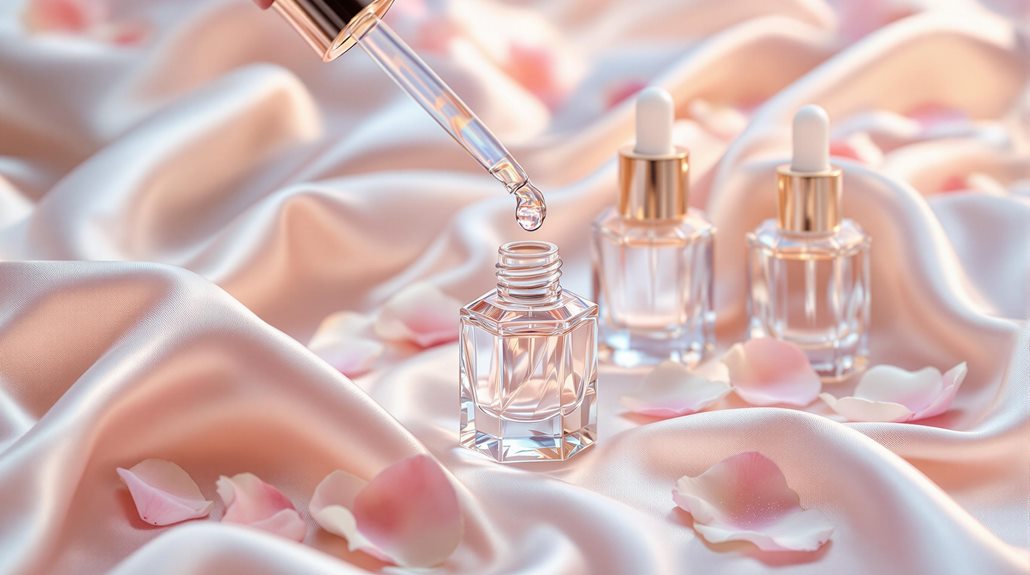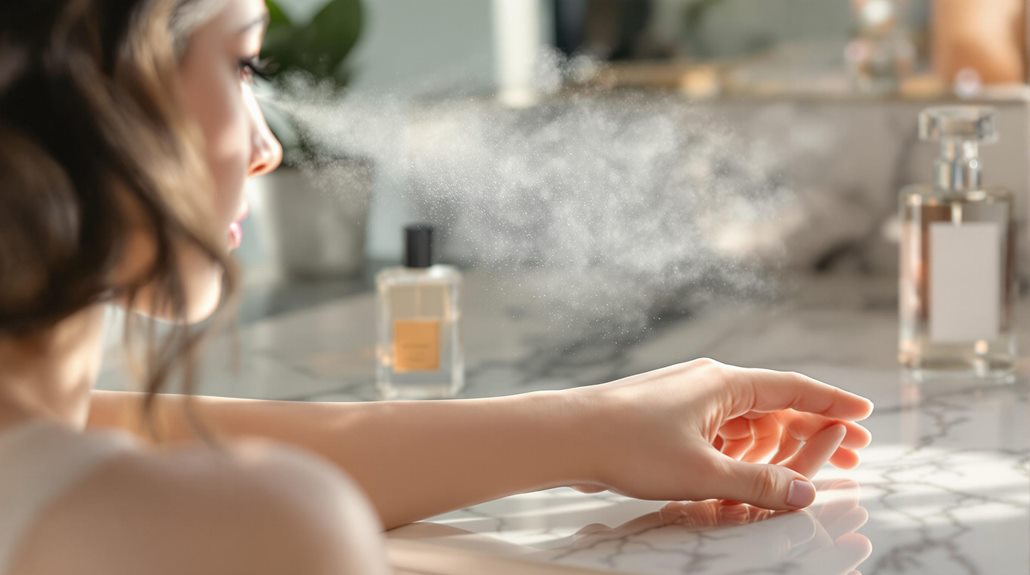How to Start a Perfume Line: Steps to Launching Your Fragrance Brand

Starting a perfume line begins with defining your unique brand vision and thoroughly researching your target market demographics. You'll need $8,000-25,000 in initial investment, depending on whether you choose existing formulations or develop custom fragrances. Partner with experienced perfumers to create your signature scent, then source reliable manufacturers who can deliver consistent quality. Focus on creating distinctive packaging that reflects your brand identity, and establish strong distribution channels through retailers and direct-to-consumer sales. Launch strategic marketing campaigns across social media and industry events to build brand awareness. These essential steps will set your fragrance brand up for long-term success and growth.
Define Your Brand Vision
Before diving into perfume creation, establish a clear and distinctive brand vision that sets your fragrance line apart from competitors. Your brand's identity should reflect your values, aesthetic preferences, and the unique story you want to tell through your fragrances. Consider what emotions and experiences you want your perfumes to evoke in your customers.
Create a detailed brand strategy that outlines your mission statement, core values, and long-term goals. Think about the essence of your brand - whether it's luxury, sustainability, innovation, or heritage. Your vision must align with your target demographic's desires and lifestyle aspirations. When launching your perfume line, guarantee every aspect of your brand identity, from packaging to marketing materials, communicates a cohesive message.
Focus on creating an emotional connection with your audience through your brand story. Your fragrances Must Appeal to both their practical needs and deeper desires. Consider factors like age range, lifestyle preferences, and purchasing power when defining your target market. Document your brand guidelines, including visual elements, tone of voice, and brand personality, to maintain consistency across all touchpoints.
Research Target Market Demographics
When developing a successful perfume line, thorough market research becomes your foundation for making informed business decisions. Understanding your target market's preferences and buying behaviors will guide your fragrance creation process and marketing strategy.
Start by analyzing demographic data, particularly focusing on age groups and gender dynamics. It's imperative to note that women make 60-70% of men's fragrance purchases, which profoundly impacts how you'll position your product. You'll need to ponder whether you're creating fragrances for daytime or evening wear, and which fragrance ingredients resonate with your intended audience.
Research cultural influences and lifestyle choices that shape your target market's preferences. Contemplate how different age groups perceive and interact with fragrances, and what psychological connections they make between scents and concepts like masculinity or femininity. Your findings will help determine whether to launch a single signature scent or multiple variations.
Document your target market's shopping habits, preferred retail channels, and price sensitivity. This information will influence your product development, packaging decisions, and distribution strategy. Remember to regularly update your research to stay aligned with transforming consumer trends and preferences.
Calculate Startup Investment Requirements
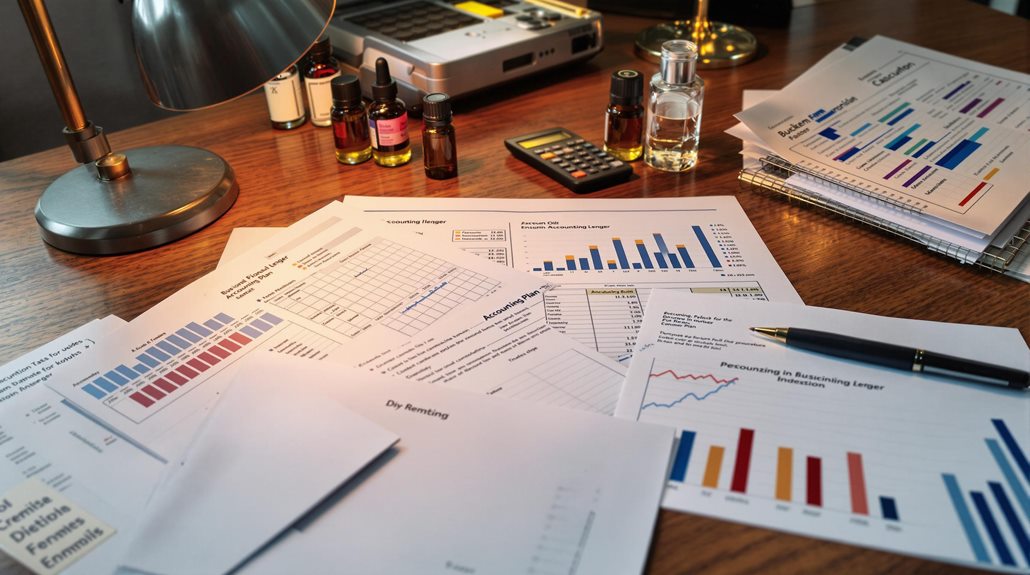
Armed with your market research observations, your next step involves calculating the precise financial investment needed to launch your perfume line. Starting a fragrance brand requires careful financial planning, with initial costs ranging from $8,000 to $10,000 for a basic launch of 200 branded bottles using an existing perfume formulation. If you're planning to create a unique fragrance from scratch, you'll need to budget between $10,000 to $25,000 for your initial investment.
To guarantee you're adequately prepared for launching your perfume line, consider these essential cost components:
- Fragrance creation or selection costs, whether using existing formulations or developing custom scents
- Production expenses including filling, assembly, and packaging of your perfume bottles
- Branding and design costs for logos, packaging, and marketing materials
- Quality control measures to maintain consistent product standards
Starting with a smaller quantity allows you to test the market while maintaining high-quality standards. Once you've successfully launched your initial batch, you can confidently scale up production based on customer demand. Remember that maintaining product quality remains pivotal regardless of your production volume, so factor this into your long-term cost projections.
Design Your Signature Fragrance
Creating your signature fragrance stands as the creative cornerstone of your perfume line. To develop a unique scent that captures your brand's essence, you'll need to partner with experienced perfumers who understand both the art and science of fragrance creation. They'll use sophisticated techniques like headspace analysis, gas chromatography, and mass spectrometry to analyze and perfect your blend.
During the creation process, you'll need to determine the type of fragrance you want to create - whether it's floral, woody, oriental, or fresh. Work closely with your perfumer to experiment with different combinations of notes, guaranteeing they align with current market trends and consumer preferences. The perfect blend should feature harmonious top notes that capture immediate attention, middle notes that maintain interest, and base notes that provide lasting appeal.
Implement rigorous quality control measures throughout development, conducting multiple rounds of testing to verify stability, longevity, and overall scent profile. Once you've achieved your desired fragrance, protect your creation by securing proper legal rights and patents. This safeguards your signature scent remains exclusively yours and helps build your brand's unique identity in the competitive perfume market.
Source Manufacturing Partners
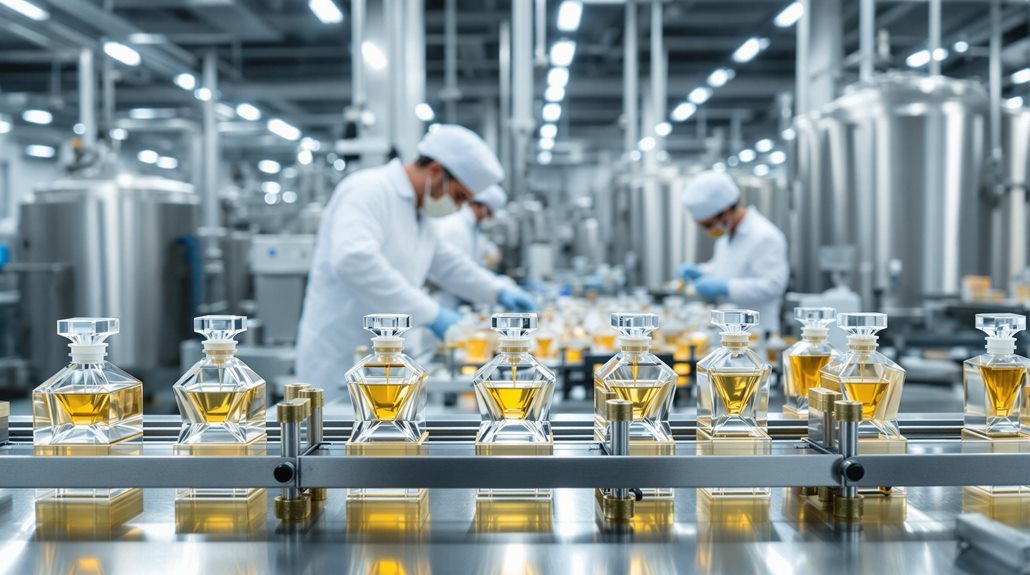
For a successful perfume line, partnering with the right manufacturer forms a critical foundation for your business. Finding a reliable manufacturing partner plays a pivotal role in transforming your fragrance vision into reality. Look for a manufacturer that offers comprehensive support throughout the entire process, from developing your signature scent to designing eye-catching packaging.
When selecting your manufacturing partner, consider these essential factors to guarantee a smooth journey in launching your new product:
- State-of-the-art tools and testing facilities to perfect your fragrance formulations
- Experience in various product categories and proven expertise in the perfume industry
- Flexible minimum order quantities that align with your business scale
- Strong track record of guiding new brands through the development process
Collaborate closely with your chosen manufacturer to create custom fragrance formulas that reflect your brand's identity and appeal to your target market. Take advantage of their sampling capabilities to refine both the scent and packaging before moving to full production. A manufacturer that streamlines procedures and provides hassle-free support will be instrumental in helping you establish a successful perfume brand.
Create Distinctive Packaging
Once you've established your manufacturing partnerships, distinctive packaging becomes your next competitive advantage. Your perfume's packaging design serves as a pivotal touchpoint between your brand and customers, making it essential to create a visually striking presentation that captures attention and reflects your brand identity.
Partner with experienced packaging designers who understand your target audience and can translate your vision into persuasive bottle designs. They'll help you investigate innovative packaging solutions that distinguish your product in the market, whether through unique printing techniques, decorative elements, or sustainable materials like refillable bottles. Your packaging should effectively communicate your fragrance's unique selling proposition while maintaining functionality and practicality.
Focus on creating a cohesive visual branding experience that extends from the bottle design to the outer packaging. Every element should work together to tell your brand's story and enhance the customer experience. Consider factors like ease of use, storage, and transportation when finalizing your design choices. Remember that exceptional packaging not only protects your product but also creates an unforgettable unboxing experience that encourages customer loyalty and word-of-mouth marketing.
Establish Distribution Channels

Building a strategic distribution network will determine your perfume line's market success and growth potential. You'll need to carefully map out your distribution strategy to guarantee your fragrances reach your target customers effectively. Consider implementing a multi-channel approach that combines traditional retail presence with direct-to-consumer sales through your brand's website and online platforms.
To establish strong distribution channels, focus on developing partnerships with retailers and distributors who can secure prime shelf space for your products. While working with distributors can expand your reach promptly, maintaining a direct-to-consumer channel gives you better control over pricing, branding, and customer relationships.
- Research and identify retailers whose customer base aligns with your target market
- Optimize your website's e-commerce capabilities to provide a seamless shopping experience
- Build relationships with distributors who have established networks in your desired markets
- Implement a mixed distribution strategy that balances online and offline presence
Your distribution strategy should remain flexible and adaptable as your brand grows. Monitor each channel's performance regularly and adjust your approach based on sales data and customer feedback to maximize your market presence and profitability.
Launch Marketing Campaign
With your distribution channels in place, a powerful marketing campaign will amplify your perfume line's visibility and attract your target customers. Start by establishing a strong social media presence across platforms like Instagram and Facebook, where you'll share engaging content, behind-the-scenes glimpses, and product updates to build brand awareness.
Implement an email marketing strategy to nurture relationships with customers, announce new launches, and offer exclusive promotions. You'll want to create captivating newsletters that keep subscribers engaged and keen to learn about your latest fragrances.
Partner with influencers, bloggers, and brand ambassadors whose aesthetics align with your brand values. Their authentic product reviews and recommendations can drastically expand your reach and credibility. Additionally, showcase your perfume line at industry events, trade shows, and pop-up shops to connect directly with potential customers and industry professionals.
Launch targeted advertising campaigns across social media platforms and Google to reach your ideal customers. Use demographic data and interest-based targeting to ensure your ads appear before the right audience. Monitor your campaign metrics closely and adjust your strategy based on performance to maximize your marketing ROI.
Scale Production Operations
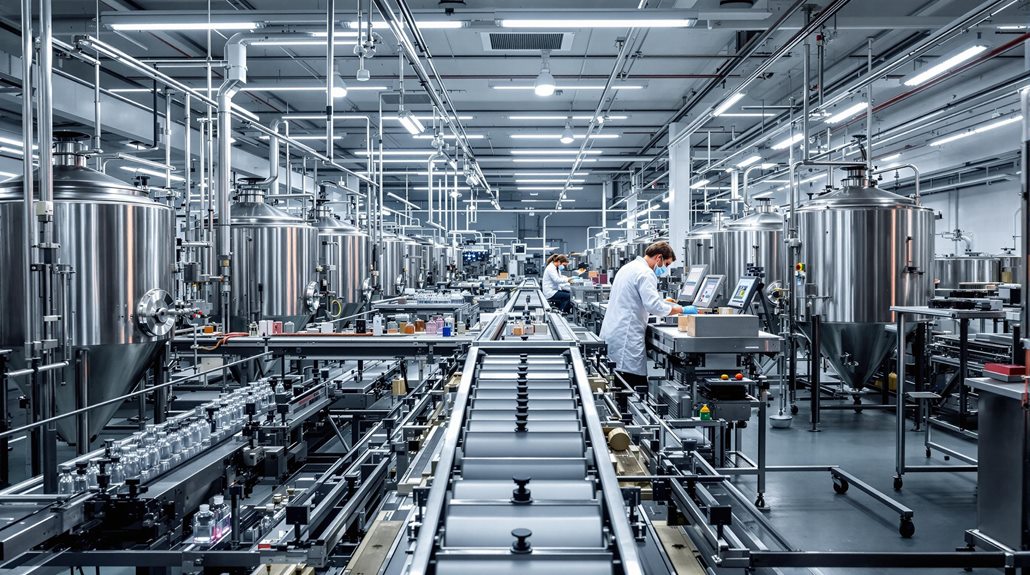
Successful scaling of your perfume production requires a strategic shift from initial small batches to larger-scale manufacturing. As you start a perfume line, you'll need to carefully balance demand with production capacity. Begin by testing the market with small batches to perfect your fragrance formulations and gauge customer response. Once you've validated your new perfume's appeal, invest in professional manufacturing equipment to increase output efficiently.
To launch your own perfume successfully and scale production operations, focus on building strong relationships with reliable fragrance suppliers. This guarantees consistent access to high-quality ingredients as your production volumes grow. Implement automated packaging and labeling systems to handle increased orders while maintaining quality control.
- Install data analytics tools to track inventory levels and forecast demand accurately
- Upgrade manufacturing equipment to handle larger batch sizes while maintaining quality
- Establish backup supplier relationships to prevent production interruptions
- Implement quality control checkpoints throughout the scaling process
When starting a fragrance business, use production data to make informed decisions about scaling. Monitor key metrics like batch yields, production efficiency, and inventory turnover to optimize your perfume launch strategy and maintain consistent product quality as you expand.
Conclusion
Starting your own perfume line is an ambitious venture that you'll need to approach strategically. By following these key steps - from defining your vision to scaling production - you're building a foundation for success in the competitive fragrance industry. Remember, you don't need to rush the process. Focus on quality, stay true to your brand identity, and keep refining your strategy as you grow your fragrance business.

